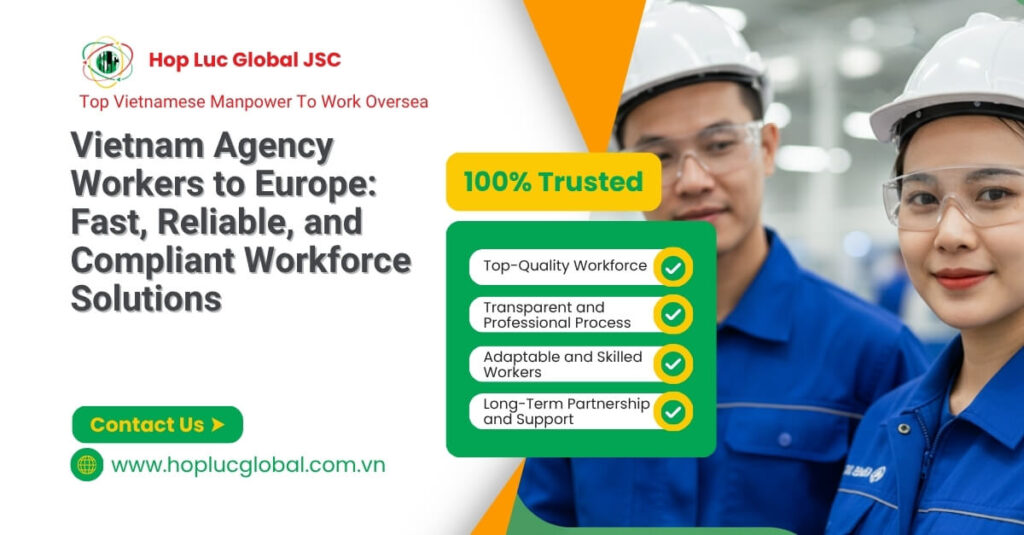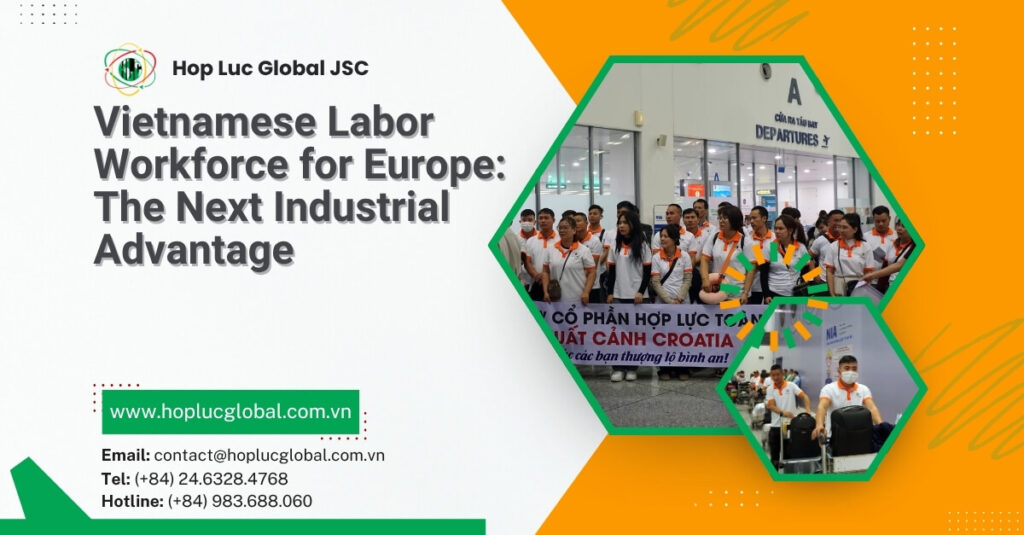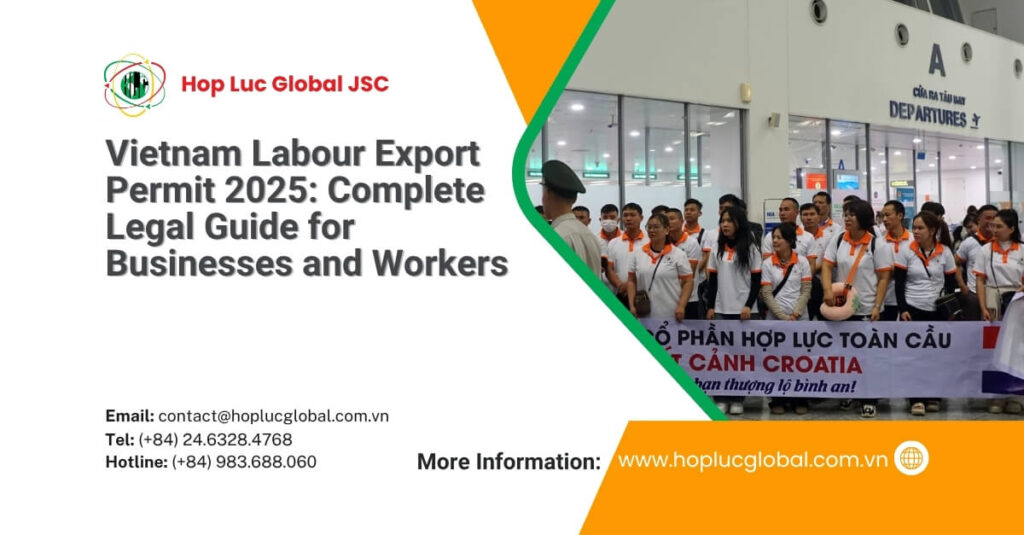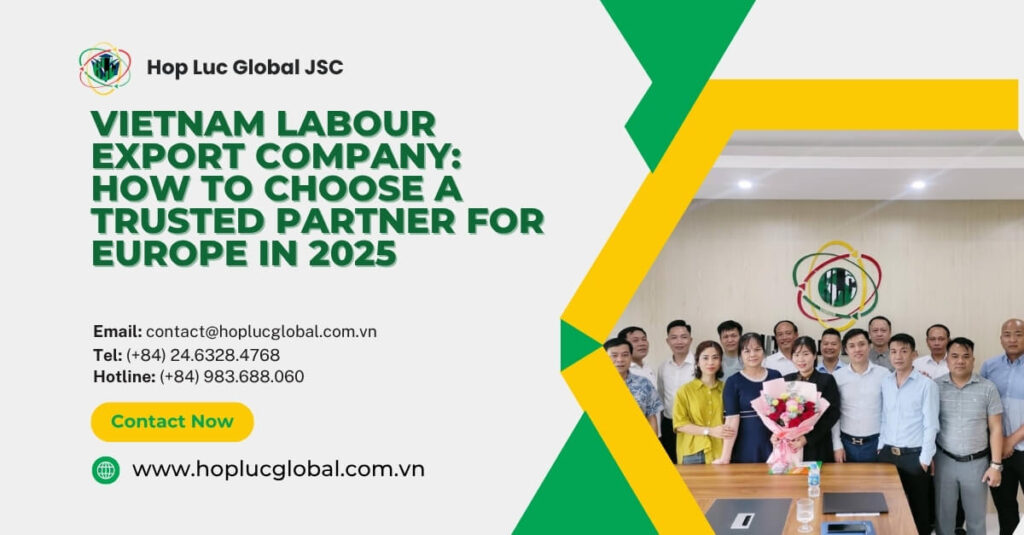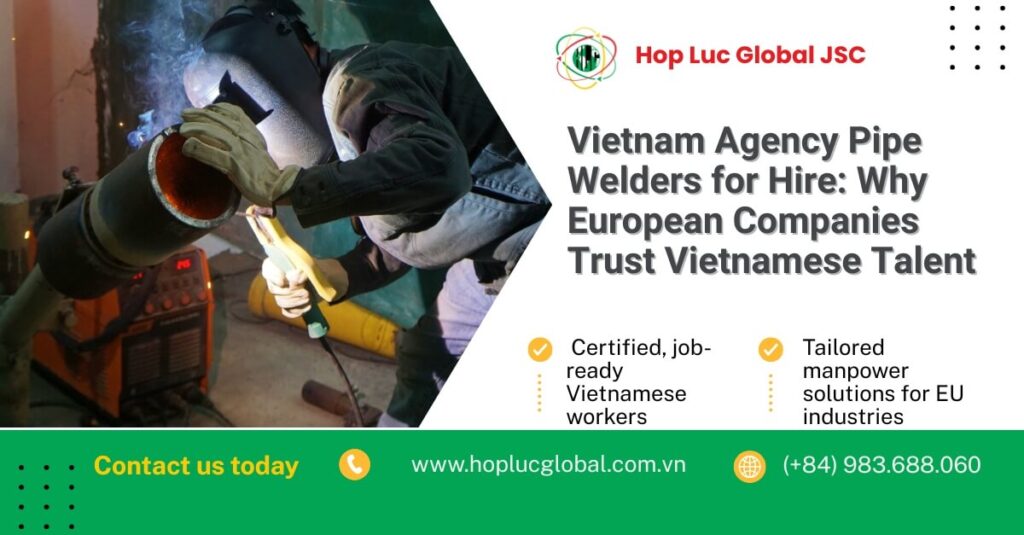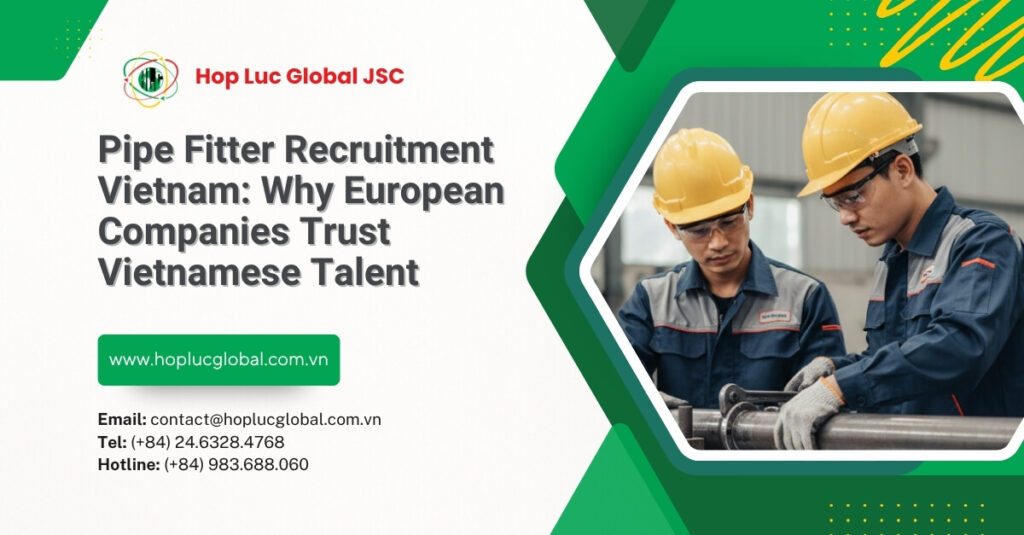Across Europe, factories, shipyards, hospitality venues, and care facilities face persistent talent gaps. The vietnamese labor workforce for europe offers a pragmatic, auditable path to fill critical roles while protecting quality, safety, and costs. This supporting article complements our pillar resource and shows EU employers how to convert shortages into output through compliant sourcing, fast mobilization, and measurable KPIs.
The vietnamese labor workforce for europe matters because it aligns skill depth with project reality. EU employers don’t need generic CVs; they need certified welders, disciplined logistics staff, and service teams who understand documentation from day one. When recruitment is treated as an engineered process—testing, files, visas, onboarding—the risk of rework and idle hours drops. That’s the operating model we describe below, with clear checkpoints you can audit.
Europe’s Talent Gap: Why Vietnamese Manpower Fits Now
Europe’s labor market is strained by aging crews, insufficient vocational throughput, and high project backlogs. For procurement leads and plant managers, vacancies translate into idle equipment, missed commissioning windows, and liquidated damages. Vietnamese manpower aligns naturally with this demand curve: young demographics, strong technical training pipelines, and a culture of diligence well suited to EU sites.
EU jobs under pressure: vacancies, aging crews, delayed projects
Industrial employers report persistent vacancies across welding, pipe fitting, CNC, logistics, and care roles—classic EU jobs where hands-on competency matters most for Europe recruitment. With retirement rates rising and training cohorts lagging, production plans slip. Vietnamese candidates add depth exactly where the bottlenecks occur, reducing rescheduling and subcontract rework.
In parallel, regional mobility alone cannot backfill the deficit. Many Member States compete for the same trades, pushing wages up while capacity stays flat. The vietnamese labor workforce for europe expands the radius without sacrificing standards. Because teams are pre-tested and briefed on EU site rules, managers gain predictable throughput instead of last-minute firefighting.
Productivity at risk without skilled labor
Without skilled labor, first-pass quality falls, punch lists expand, and schedules drift. Every delayed weld, inspection, or room turn-over compounds cost. Bringing in trained Vietnamese teams stabilizes takt times, raises productivity, and protects throughput during shutdowns, seasonal peaks, or multi-site rollouts.
Another hidden cost is managerial attention. Supervisors lose time coaching basics instead of removing bottlenecks. With the vietnamese labor workforce for europe, crews arrive with practical English/German for toolbox talks and a habit of closing punch items. That frees supervisors to focus on schedule-critical workfronts, not remedial training.
For the wider policy context, visa options, and contract models, see our Vietnam labour export guide 2025.
Skills That Travel: What Sets the Vietnamese Labor Workforce for Europe Apart
EU hiring isn’t just about filling seats—it’s about placing people who meet technical codes, site discipline, and documentation standards from day one. The vietnamese labor workforce for europe stands out on three auditable fronts.
Trade depth for priority sectors
A frequent question is whether skills translate to code-specific outcomes. The vietnamese labor workforce for europe is trained against EN ISO 9606-1, food safety, and care standards where relevant. Evidence is shared: test videos, assessor notes, and weld maps or service checklists. This transparency speeds client approvals.
Priority roles include welders and pipe fitters (EN ISO 9606-1 alignment), fabricators, CNC/assembly techs, logistics coordinators, hotel F&B teams, and care assistants. This breadth lets EU employers cover both industrial and service ramps with the right skilled labor mix.
Language, HSE and site discipline
Candidates prepare for A2–B1 workplace English/German, safety dialogues, and toolbox talks. They respect hot-work permits, LOTO, confined-space rules, and HACCP protocols in hospitality—habits essential for EU sites where precision and documentation matter.
Speaking the language of safety is non-negotiable. The vietnamese labor workforce for europe completes HSE inductions that cover hot-work permits, lockout/tagout, and confined-space entries. That discipline is reinforced during the first week on site, reducing near misses and helping pass audits smoothly.
Documentation discipline you can audit
Reputable partners provide certificates, medicals, insurance, police checks, and GDPR consents in organized electronic packs—materials EU auditors expect to see. This is where mature Vietnamese manpower programs differentiate: clean files, clear ownership, faster onboarding.
From Brief to Site: 30–60 Day Mobilization for EU Projects
Predictability wins projects. Below is a realistic roadmap used by compliant providers to mobilize the vietnamese labor workforce for europe within 30–60 days, depending on embassy capacity and role scarcity.

Week 1–2: Role brief, sourcing, shortlist
- Employer shares role specs, relevant codes/standards, language level, site conditions.
- Agency sources via trade schools, regional centers, and alumni networks; pre-screens resumes and videos.
- Shortlist invitations issued with testing dates and required documentation.
Week 3–5: Testing, visas, insurance
- Hands-on trade tests under EU-comparable conditions; HSE induction and medicals.
- Employment contracts, visa submissions, and insurance finalized; GDPR-secure files created.
- Embassy appointments sequenced to protect schedule float.
Week 6–8: Travel, onboarding, first-week KPIs
- Flights, airport pickup, housing verification, local registrations.
- Site induction, PPE/tools issue, supervisor pairing, look-ahead plan.
- First-week productivity tracked against a mutually agreed baseline.
Support your business case with market indicators (e.g., labor shortages and vacancy rates) from reliable sources such as Eurostat here.
Many buyers map testing windows to shutdown calendars. The vietnamese labor workforce for europe can be mobilised in waves, matching visa slots to look-ahead schedules so commissioning, hydrotests, or room openings do not slip. Predictability is the advantage.
Compliance & Ethics for the Vietnamese Labor Workforce for Europe
De-risking procurement is non-negotiable. The vietnamese labor workforce for europe must be sourced through licensed operators with transparent files and ethical safeguards.

MOLISA licensing & audit-ready archives
Always insist on a named legal representative and verified training addresses. The vietnamese labor workforce for europe should be supported by a provider that can share redacted past projects, proving file integrity and welfare practices on real deployments.
Ask for MOLISA licence details, registered addresses, and scope. Expect digital archives with version control and time-stamped access—materials you can audit anytime. Learn more about licensing frameworks via Vietnam’s MOLISA official portal.
Review the key export permit requirements before contracting.
Worker welfare & CSR standards
Wellbeing drives retention: safe housing, transport policies, insurance, and grievance channels. Ethical fee policies and clear payroll explainers reduce friction and strengthen employer reputation.
Data protection for EU deployments
GDPR-aligned consent forms, access controls, and retention policies protect personal data. Incident reporting and DPIAs should be baked into the operating model, not added later.
For a partner-evaluation perspective, also review our guidance on agency due diligence on the Hop Luc site: Vietnam labour export company.
Measured ROI of the Vietnamese Labor Workforce for Europe
People decisions are financial decisions. When you bring certified teams instead of CV stacks, total cost of ownership (TCO) drops and throughput stabilizes.
Lower TCO vs. general recruiters/brokers
Specialist programs reduce rework, onboarding churn, and admin time. Predictable mobilization shrinks contingency buffers and avoids premium last-minute hires.
Quality and schedule KPIs
When crews arrive fully briefed, managers hit stable takt times faster. The vietnamese labor workforce for europe consistently reduces weld repair rates, room turn-around variance, and idle hours during TARs. Those are measurable P&L impacts, not soft benefits.
Track first-pass yield, hydrotest readiness, weld repair rates, and punch-list burn-down. In services, watch room readiness, guest-sat scores, or care compliance indicators.
Stability and replacement SLAs
Clear replacement windows (90–180 days), escalation paths, and coaching loops keep lines productive without repeated hiring cycles.
| Provider Type | Compliance Risk | Time-to-Productivity | TCO Outlook |
|---|---|---|---|
| Specialist agency (licensed) | Low – audit-ready packs | Fast – trained, pre-tested | Best – fewer reworks/churn |
| General recruiter | Medium – fragmented files | Moderate – site retraining | Mixed – hidden admin costs |
| Broker/Informal | High – legal exposure | Slow – variable skills | Poor – delays & penalties |
For a structured partner assessment, see our company evaluation checklist.
Where the Vietnamese Labor Workforce for Europe Excels
Strength comes from precise trade matching and sector fluency. Here are typical EU use cases where Vietnamese teams deliver outsized value.
Sector experience matters. The vietnamese labor workforce for europe is strongest where procedures are precise and documentation heavy—shipbuilding, energy/process, hospitality, and care. Below are micro-cases showing fit.
Shipbuilding & offshore modules
Certified welders and fitters work to tight tolerances in confined spaces. They follow marine class requirements and coordinate with NDT teams to hit launch windows.
Energy & process plants
Pipe classes, isos, and hydrotest sequencing demand rigor. Vietnamese crews align to control points, reducing rework during shutdowns (TARs) and turnarounds.
Hospitality & healthcare support
Service discipline matters. Hotel operations and care facilities rely on predictable teams that respect hygiene protocols, documentation, and guest/patient outcomes.
How Hop Luc Global Delivers the Vietnamese Labor Workforce for Europe
Hop Luc Global JSC structures manpower like an engineered product—tested, documented, and supported on site. That’s how we protect schedules and reputations.
Governance & licences
Valid permits, named legal representatives, and digital certification archives are standard. Clients get transparent access for audits and spot checks.
Testing & Training for the Vietnamese Labor Workforce for Europe
EN-aligned test bays simulate EU work. Sector modules (shipbuilding, energy/process, hospitality/care) shorten time-to-productivity while lifting quality.
On-site support & retention >85%
Bilingual coordination, welfare audits, and early-days coaching stabilize crews. Replacement SLAs and performance dashboards keep the program accountable.
CTA: Request a 7–10 day shortlist tailored to your roles and standards.
Buyer’s Brief: What to Send for Faster Matching
Great inputs create great outcomes. Share the details below to speed matching and reduce back-and-forth.
Technical inputs
- Role mix, codes/standards, wall thickness/materials, and any alternative processes allowed.
- Language expectations by role, medical prerequisites, and tool/PPE responsibilities.
- Site access, shift pattern, climatic conditions, and special permits.
Operations & KPIs
- Look-ahead schedule, milestone criteria, and acceptance thresholds.
- Reporting cadence (daily/weekly) and data formats for dashboards.
- Replacement SLAs and training/coaching ownership.
Welfare & CSR expectations
- Housing standards, transport, and cultural integration support.
- HSE briefing flows, grievance channels, and supervisor pairing.
- Audit rights and privacy commitments.
For the end-to-end export steps and legal pathways, revisit our Vietnam labour export guide 2025.
FAQs: Vietnamese Labor Workforce for Europe (Quick Answers)
- How do I verify a licence? Ask for the MOLISA licence and check registered addresses and scope. Confirm digital archive access and compliance letters.
- Typical deployment timeline? 30–60 days from brief to arrival, depending on embassy capacity and role scarcity.
- What English/German level is realistic? A2–B1 workplace fluency for most industrial/service roles; higher for customer-facing positions.
- Which sectors are strongest in 2025? Shipbuilding/offshore, energy/process plants, logistics, hospitality, and selected care roles.
- What does an audit pack include? Certificates, medicals, insurance, police checks, GDPR consents, training logs, and contracts.
- Where can I learn the legal process and timelines? See the detailed pillar: Vietnam labour export guide 2025.
Get Started: Turn Shortages into Execution
Talent gaps won’t fix themselves. If your program needs predictable deployment, defensible compliance, and stable KPIs, partner with a provider that treats manpower as a managed, auditable asset. The vietnamese labor workforce for europe can protect schedules, raise first-pass quality, and reduce TCO—when sourced and supported correctly.
Connect with Hop Luc Global JSC to scope roles and receive an audit-ready shortlist within 7–10 days. Share your role profiles, codes, and schedule, and we will align testing, documentation, and onboarding to your plan. Together we can turn shortages into reliable execution from brief to site.
Contact us via:
-
Email: contact@hoplucglobal.com
-
WhatsApp: +84 983 688 060
Your plan needs people who convert scope into output. Partnering around the vietnamese labor workforce for europe gives you audited files, tested crews, and a 30–60 day path to site. Share your roles and schedule to receive a shortlist that you can verify and deploy.

